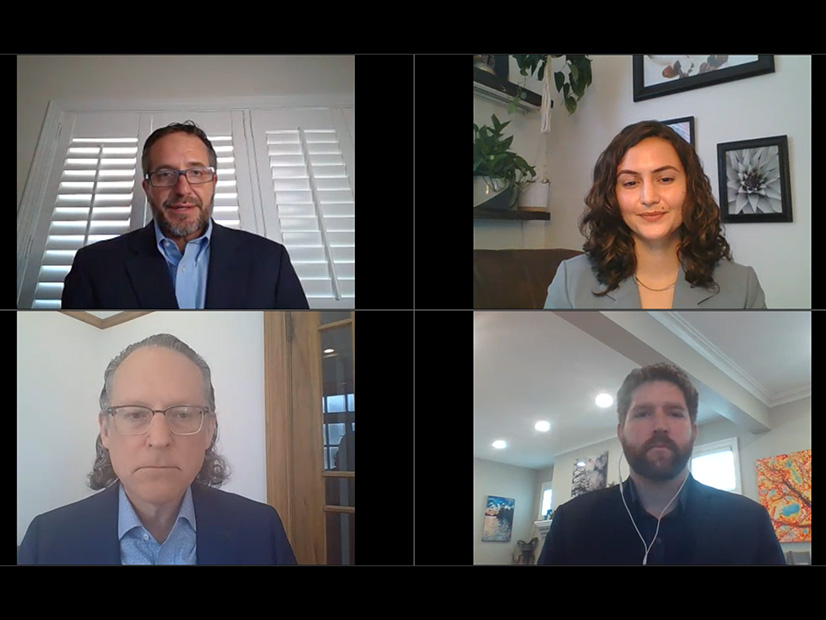
Proponents of a federal clean electricity standard (CES) say it would be a potentially powerful tool in reducing greenhouse gas emissions and meeting the Biden administration’s goals of reaching 100% clean electricity generation by 2035 and net-zero carbon emissions by 2050.
The idea’s opponents range from those who support carbon pricing, to those seeking changes to planning process regulations. As part of its energy leaders webinar series, OurEnergyPolicy brought in experts on both sides of the debate Wednesday to discuss the benefits and drawbacks of adopting a national CES.
Decarbonizing the power sector is a “crucial piece” of reaching net-zero emissions by 2050, said Lindsey Walter, deputy director of climate and energy Third Way, a D.C.-based think tank.
A well designed CES could be a very efficient way of achieving low-cost emission reductions, according to Arne Olson of Energy and Environmental Economics. He said that a CES “lines up very well” with studies he has been a part of, including one on PJM in October that recommended a carbon pricing regime. (See Study Recommends Carbon Price for PJM.)
However, a CES could stimulate artificial demand for clean energy, especially when state policies and organic market demand are already driving deep decarbonization, posited Devin Hartman, director of energy and environmental policy at R Street Institute.
“The regulatory state simply isn’t letting us deploy capital and manage it in an efficient way sufficient to meet that existing demand,” Hartman said. “What we need to do, if we’re serious about the clean energy transition in a results-oriented way, is to start talking about how to reform the regulatory apparatus, especially things tied to the planning, permitting and siting processes, and anything that ultimately fuses competition into the generation and transmission components of electric supply.”
Any CES design has to be technology-inclusive, Walter said, to ensure that all zero- or low-carbon technologies can compete.
“Nuclear and carbon capture are going to be fundamental toward ensuring we’re not only decarbonizing our grid, but we also still have those firm dispatchable resources that we need to ensure reliability,” Walter said.
While it is not the “ideal policy,” enacting a CES is something that Congress can do now, Olson added. When it comes to specific design elements, a CES “needs to be simple,” starting with technology inclusivity and some quick math.
“It’s megawatt-hours and clean energy generated, divided by megawatt-hours of retail sales,” Olson said. “That’s very simple. You can generate a [renewable energy certificate] by generating a megawatt-hour of clean energy anywhere, and those can be traded in the secondary market very efficiently.”
There is “no silver bullet policy” to address climate change, Walter said, but a CES would allow for complementary policies such as building out of transmission lines.
“We have a lot of room for improvement in market design … to let that transition occur in a way that’s cost-effective and reliable and also gives reliability authorities the confidence that we can manage this transition in a reliable fashion,” Hartman said.
Smith Talks About ‘Pivotal Moment’
Whether it is droughts, floods, fires or lack of a federal CES, U.S. Sen. Tina Smith (D-Minn.) said the country is at a “pivotal moment on climate action.”
“The cost of inaction on climate is too high,” Smith said in remarks opening the webinar.
Many Democrats, including Smith, favor a federal CES, which she sees as a straightforward way to mandate 80% carbon-free electricity by 2030 and reach net-zero emissions on the grid by 2035. The CES is also part of the budget that Senate Democrats will likely have to pass through the reconciliation process. In addition, Smith said a CES provides the “right kind of incentives for utilities” because “anything that is clean counts” toward the incentives envisioned in the budget.
Utilities face no penalty or gain any advantage to being at “40% clean energy versus 10% clean energy,” according to Smith, who ultimately wants them “to see a path for adding clean energy.”

